
Austrostipa is a primarily Australian genus of plants in the grass family, commonly called speargrass.

Aegiceras is a genus of trees and shrubs from Southeast Asia, Malesia, Australia and the Pacific Island,. and in Australia, in the Northern Territory, Queensland, New South Wales, and Western Australia. They occur as mangroves in coastal or estuarine areas.
Austrostipa variabilis is a species of grass in the family Poaceae that grows in southern parts of Australia.
Austrostipa crinita is a species of grass that grows in coastal parts of midwest Western Australia.
Stemona australiana is a plant species native to tropical south-east Asia, including northern Australia and Papua New Guinea. It grows as a herb or climber up to two metres high.

Dichelachne is a genus of Australian, Indonesian, and Pacific Island plants in the grass family. They are known commonly as plumegrasses.
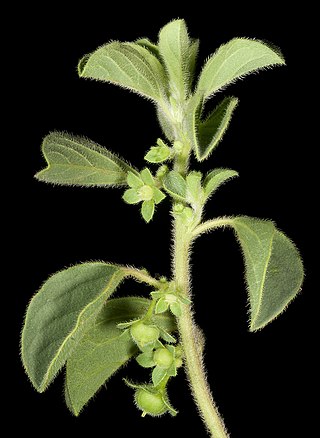
Notoleptopus is a monotypic genus of flowering plants in the family Phyllanthaceae. It is one of eight genera in the tribe Poranthereae. The sole species is Notoleptopus decaisnei. It is a monoecious shrub, native to Australia, New Guinea, and Indonesia.

Dicrastylis is a genus of plants in the Lamiaceae, first described in 1855. The entire genus is endemic to Australia. The type species is Dicrastylis fulva.
Austrostipa compressa, the compact needlegrass, originally described as Stipa compressa, is a species of grass that grows in south west Western Australia.
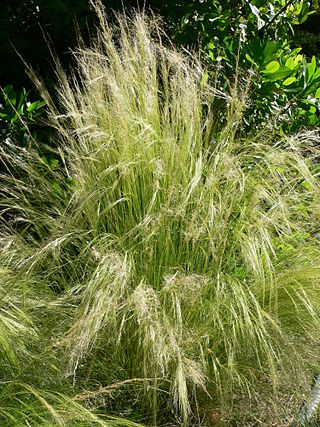
Nassella tenuissima is a species of grass known by the common names Mexican feathergrass, finestem needlegrass, fineleaved nassella, and Argentine needle-grass. It is native to the south-western United States, northern Mexico and Argentina. It is well-matched to climate in Australia and can be harmful to the Australian environment.

Austrostipa elegantissima, commonly known as tall feather-grass, is a species of grass in the family Poaceae. It is native to southern Australia, from Western Australia to New South Wales. It grows as a decumbent perennial in a rhizomatous tussock with widespread leaves. It lacks basal leaves. It is found in areas that are not grazed by introduced livestock, which feed on this plant.
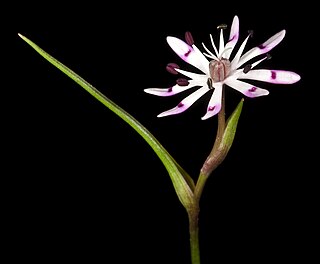
Wurmbea tenella, common name - eight nancy, is a perennial herb in the Colchicaceae family that is native to Western Australia.
Calotis pubescens is a species of daisy endemic to Australia and found in New South Wales and Victoria.
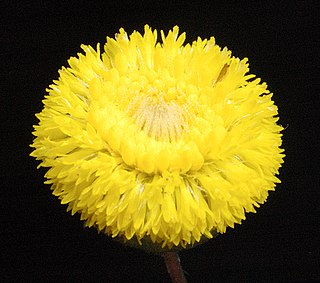
Podolepis lessonii is an erect annual herb native to Western Australia, belonging to the Asteraceae family.

Austrostipa puberula is a plant species from the genus Austrostipa. This species was originally described by Surrey Wilfrid Laurance Jacobs and Joy Everett.

Pembertonia latisquamea is a species of daisy (Asteraceae), native to Western Australia. It was first described by Ferdinand von Mueller in 1878 as Brachyscome latisquamea and transferred to the genus, Pembertonia in 2004 by Philip Short.

Hybanthus floribundus is a plant in the Violaceae family, found in southern Western Australia, southern South Australia, Victoria and southern New South Wales.
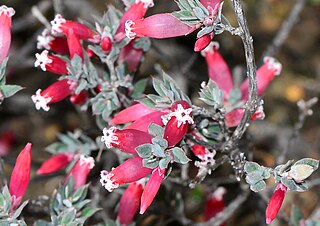
Styphelia stricta is a small plant in the family Ericaceae. It is endemic to Western Australia.

Austrostipa mollis, also known as the soft speargrass or supple speargrass is a robust, erect tufted perennial speargrass in the Poaceae family. It is native to Australia, and found in Western Australia, South Australia, Victoria, ACT and Tasmania.

Schoenus nanus is a species of sedge endemic to Australia, and found in Western Australia, South Australia and Victoria. It was first described in 1844 by Christian Gottfried Daniel Nees von Esenbeck as Chaetospora nana, but in 1878 was transferred by George Bentham to the genus, Schoenus.















